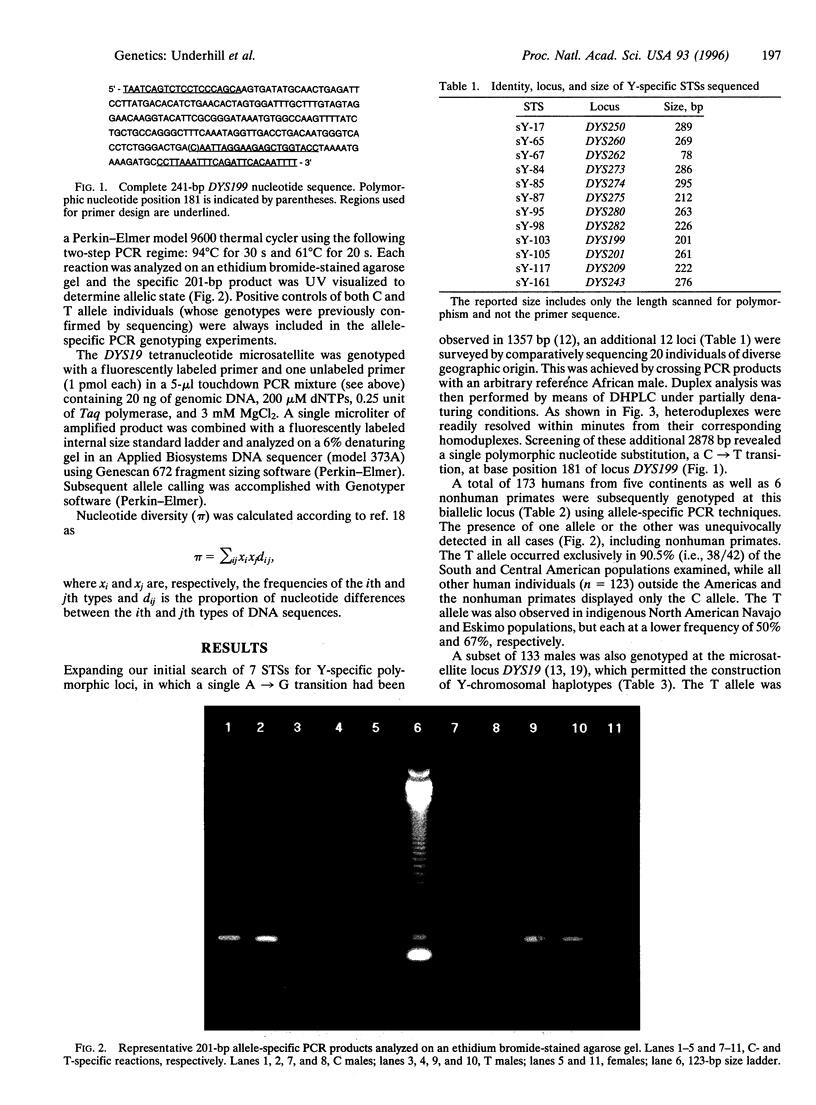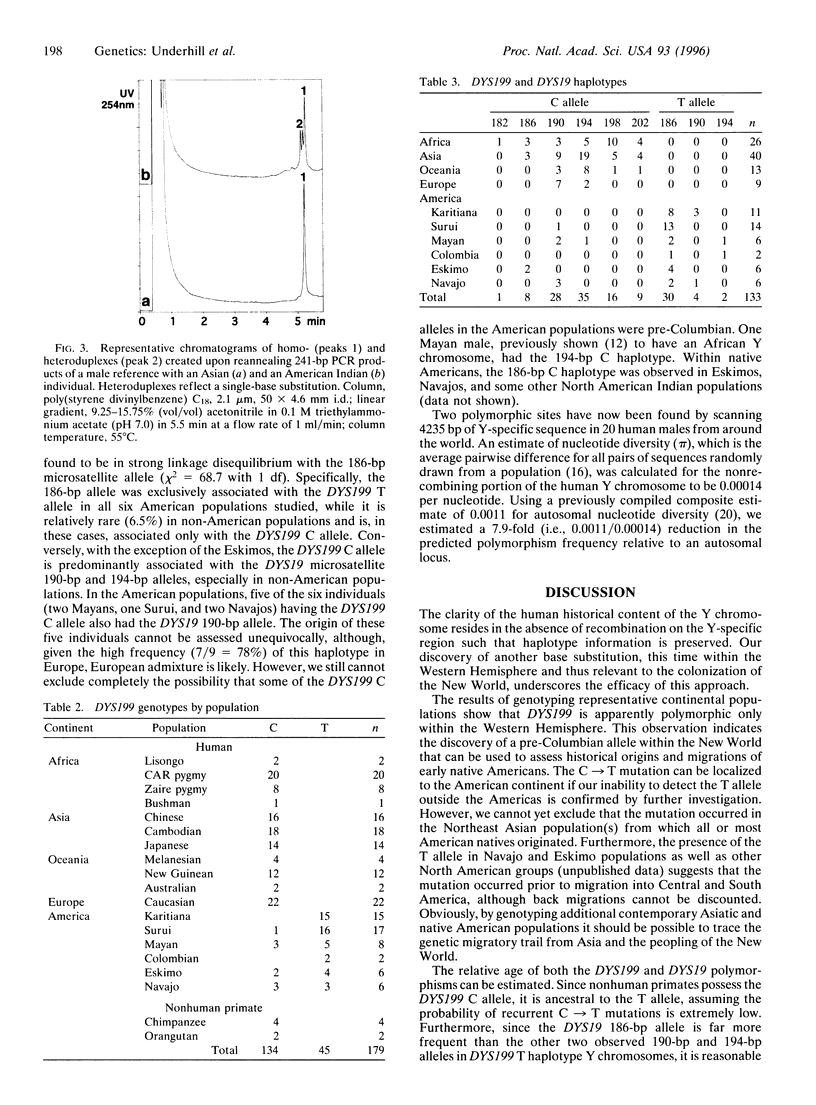Abstract
A polymorphic C-->T transition located on the human Y chromosome was found by the systematic comparative sequencing of Y-specific sequence-tagged sites by denaturing high-performance liquid chromatography. The results of genotyping representative global indigenous populations indicate that the locus is polymorphic exclusively within the Western Hemisphere. The pre-Columbian T allele occurs at > 90% frequency within the native South and Central American populations examined, while its occurrence in North America is approximately 50%. Concomitant genotyping at the polymorphic tetranucleotide microsatellite DYS19 locus revealed that the C-->T mutation displayed significant linkage disequilibrium with the 186-bp allele. The data suggest a single origin of linguistically diverse native Americans with subsequent haplotype differentiation within radiating indigenous populations as well as post-Columbian European and African gene flow. The mutation may have originated either in North America at a very early time during the expansion or before it, in the ancestral population(s) from which all Americans may have originated. The analysis of linkage of the DYS199 and the DYS19 tetranucleotide loci suggests that the C-->T mutation may have occurred around 30,000 years ago. We estimate the nucleotide diversity over 4.2 kb of the nonrecombining portion of the Y chromosome to be 0.00014. compared to autosomes, the majority of variation is due to the smaller effective population size of the Y chromosome rather than selective sweeps. There begins to emerge a pattern of pronounced geographical localization of Y-specific nucleotide substitution polymorphisms.
Full text
PDF




Images in this article
Selected References
These references are in PubMed. This may not be the complete list of references from this article.
- Berry A. J., Ajioka J. W., Kreitman M. Lack of polymorphism on the Drosophila fourth chromosome resulting from selection. Genetics. 1991 Dec;129(4):1111–1117. doi: 10.1093/genetics/129.4.1111. [DOI] [PMC free article] [PubMed] [Google Scholar]
- Casanova M., Leroy P., Boucekkine C., Weissenbach J., Bishop C., Fellous M., Purrello M., Fiori G., Siniscalco M. A human Y-linked DNA polymorphism and its potential for estimating genetic and evolutionary distance. Science. 1985 Dec 20;230(4732):1403–1406. doi: 10.1126/science.2999986. [DOI] [PubMed] [Google Scholar]
- Chakraborty R. Simulation results with stepwise mutation model and their interpretations. J Mol Evol. 1977 Aug 5;9(4):313–322. doi: 10.1007/BF01796093. [DOI] [PubMed] [Google Scholar]
- Don R. H., Cox P. T., Wainwright B. J., Baker K., Mattick J. S. 'Touchdown' PCR to circumvent spurious priming during gene amplification. Nucleic Acids Res. 1991 Jul 25;19(14):4008–4008. doi: 10.1093/nar/19.14.4008. [DOI] [PMC free article] [PubMed] [Google Scholar]
- Dorit R. L., Akashi H., Gilbert W. Absence of polymorphism at the ZFY locus on the human Y chromosome. Science. 1995 May 26;268(5214):1183–1185. doi: 10.1126/science.7761836. [DOI] [PubMed] [Google Scholar]
- Hammer M. F. A recent insertion of an alu element on the Y chromosome is a useful marker for human population studies. Mol Biol Evol. 1994 Sep;11(5):749–761. doi: 10.1093/oxfordjournals.molbev.a040155. [DOI] [PubMed] [Google Scholar]
- Hammer M. F., Horai S. Y chromosomal DNA variation and the peopling of Japan. Am J Hum Genet. 1995 Apr;56(4):951–962. [PMC free article] [PubMed] [Google Scholar]
- Huber C. G., Oefner P. J., Bonn G. K. High-resolution liquid chromatography of oligonucleotides on nonporous alkylated styrene-divinylbenzene copolymers. Anal Biochem. 1993 Aug 1;212(2):351–358. doi: 10.1006/abio.1993.1340. [DOI] [PubMed] [Google Scholar]
- Li W. H., Sadler L. A. Low nucleotide diversity in man. Genetics. 1991 Oct;129(2):513–523. doi: 10.1093/genetics/129.2.513. [DOI] [PMC free article] [PubMed] [Google Scholar]
- Luria S. E., Delbrück M. Mutations of Bacteria from Virus Sensitivity to Virus Resistance. Genetics. 1943 Nov;28(6):491–511. doi: 10.1093/genetics/28.6.491. [DOI] [PMC free article] [PubMed] [Google Scholar]
- Malaspina P., Persichetti F., Novelletto A., Iodice C., Terrenato L., Wolfe J., Ferraro M., Prantera G. The human Y chromosome shows a low level of DNA polymorphism. Ann Hum Genet. 1990 Oct;54(Pt 4):297–305. doi: 10.1111/j.1469-1809.1990.tb00385.x. [DOI] [PubMed] [Google Scholar]
- Mathias N., Bayés M., Tyler-Smith C. Highly informative compound haplotypes for the human Y chromosome. Hum Mol Genet. 1994 Jan;3(1):115–123. doi: 10.1093/hmg/3.1.115. [DOI] [PubMed] [Google Scholar]
- Nei M., Li W. H. Mathematical model for studying genetic variation in terms of restriction endonucleases. Proc Natl Acad Sci U S A. 1979 Oct;76(10):5269–5273. doi: 10.1073/pnas.76.10.5269. [DOI] [PMC free article] [PubMed] [Google Scholar]
- Ngo K. Y., Vergnaud G., Johnsson C., Lucotte G., Weissenbach J. A DNA probe detecting multiple haplotypes of the human Y chromosome. Am J Hum Genet. 1986 Apr;38(4):407–418. [PMC free article] [PubMed] [Google Scholar]
- Pena S. D., Santos F. R., Bianchi N. O., Bravi C. M., Carnese F. R., Rothhammer F., Gerelsaikhan T., Munkhtuja B., Oyunsuren T. A major founder Y-chromosome haplotype in Amerindians. Nat Genet. 1995 Sep;11(1):15–16. doi: 10.1038/ng0995-15. [DOI] [PubMed] [Google Scholar]
- Päbo S. The Y chromosome and the origin of all of us (men) Science. 1995 May 26;268(5214):1141–1142. doi: 10.1126/science.7761828. [DOI] [PubMed] [Google Scholar]
- Roewer L., Arnemann J., Spurr N. K., Grzeschik K. H., Epplen J. T. Simple repeat sequences on the human Y chromosome are equally polymorphic as their autosomal counterparts. Hum Genet. 1992 Jun;89(4):389–394. doi: 10.1007/BF00194309. [DOI] [PubMed] [Google Scholar]
- Santos F. R., Pena S. D., Epplen J. T. Genetic and population study of a Y-linked tetranucleotide repeat DNA polymorphism with a simple non-isotopic technique. Hum Genet. 1993 Feb;90(6):655–656. doi: 10.1007/BF00202486. [DOI] [PubMed] [Google Scholar]
- Seielstad M. T., Hebert J. M., Lin A. A., Underhill P. A., Ibrahim M., Vollrath D., Cavalli-Sforza L. L. Construction of human Y-chromosomal haplotypes using a new polymorphic A to G transition. Hum Mol Genet. 1994 Dec;3(12):2159–2161. doi: 10.1093/hmg/3.12.2159. [DOI] [PubMed] [Google Scholar]
- Spurdle A., Jenkins T. Y chromosome probe p49a detects complex PvuII haplotypes and many new TaqI haplotypes in southern African populations. Am J Hum Genet. 1992 Jan;50(1):107–125. [PMC free article] [PubMed] [Google Scholar]
- Szathmary E. J. mtDNA and the peopling of the Americas. Am J Hum Genet. 1993 Oct;53(4):793–799. [PMC free article] [PubMed] [Google Scholar]
- Torroni A., Chen Y. S., Semino O., Santachiara-Beneceretti A. S., Scott C. R., Lott M. T., Winter M., Wallace D. C. mtDNA and Y-chromosome polymorphisms in four Native American populations from southern Mexico. Am J Hum Genet. 1994 Feb;54(2):303–318. [PMC free article] [PubMed] [Google Scholar]
- Tyler-Smith C., Taylor L., Müller U. Structure of a hypervariable tandemly repeated DNA sequence on the short arm of the human Y chromosome. J Mol Biol. 1988 Oct 20;203(4):837–848. doi: 10.1016/0022-2836(88)90110-6. [DOI] [PubMed] [Google Scholar]
- Vollrath D., Foote S., Hilton A., Brown L. G., Beer-Romero P., Bogan J. S., Page D. C. The human Y chromosome: a 43-interval map based on naturally occurring deletions. Science. 1992 Oct 2;258(5079):52–59. doi: 10.1126/science.1439769. [DOI] [PubMed] [Google Scholar]
- Watterson G. A., Guess H. A. Is the most frequent allele the oldest? Theor Popul Biol. 1977 Apr;11(2):141–160. doi: 10.1016/0040-5809(77)90023-5. [DOI] [PubMed] [Google Scholar]
- Weber J. L., Wong C. Mutation of human short tandem repeats. Hum Mol Genet. 1993 Aug;2(8):1123–1128. doi: 10.1093/hmg/2.8.1123. [DOI] [PubMed] [Google Scholar]



